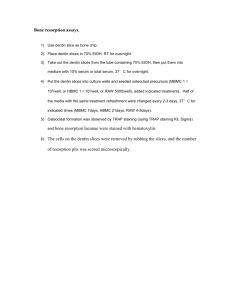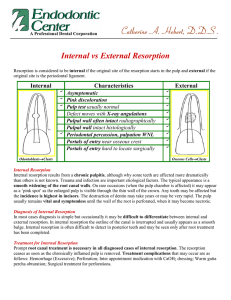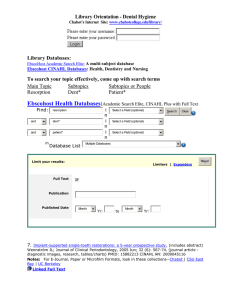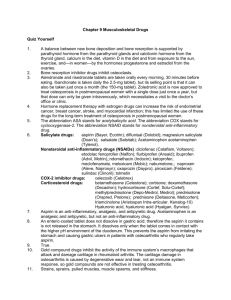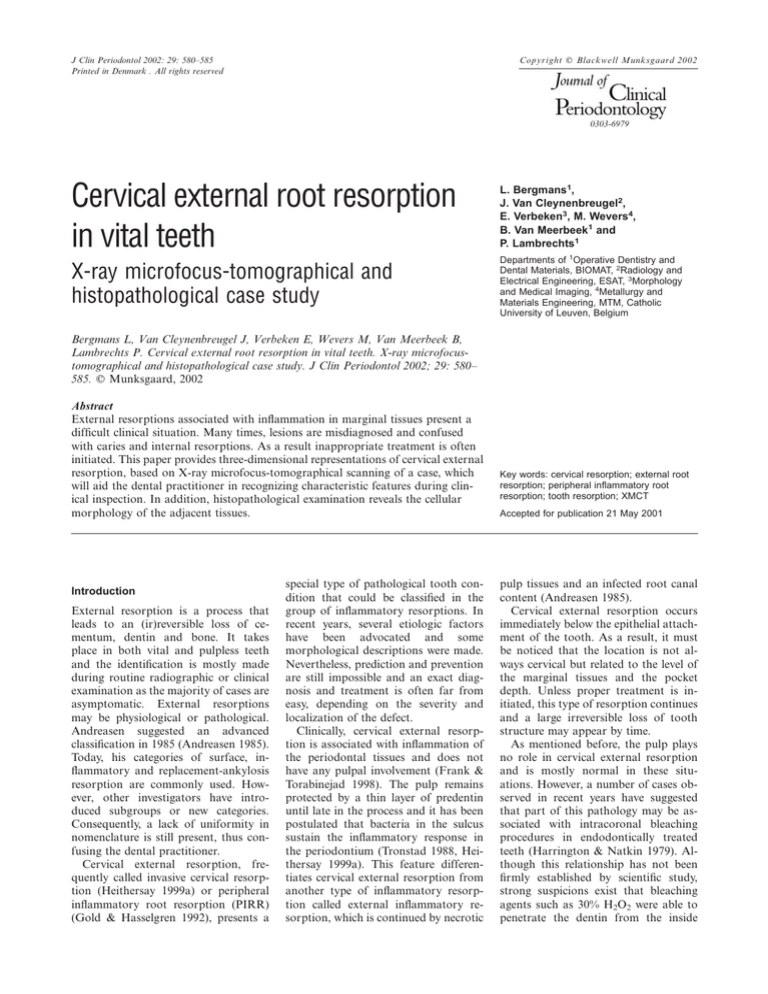
Copyright C Blackwell Munksgaard 2002
J Clin Periodontol 2002: 29: 580–585
Printed in Denmark . All rights reserved
0303-6979
Cervical external root resorption
in vital teeth
L. Bergmans1,
J. Van Cleynenbreugel2,
E. Verbeken3, M. Wevers4,
B. Van Meerbeek1 and
P. Lambrechts1
X-ray microfocus-tomographical and
histopathological case study
Departments of 1Operative Dentistry and
Dental Materials, BIOMAT, 2Radiology and
Electrical Engineering, ESAT, 3Morphology
and Medical Imaging, 4Metallurgy and
Materials Engineering, MTM, Catholic
University of Leuven, Belgium
Bergmans L, Van Cleynenbreugel J, Verbeken E, Wevers M, Van Meerbeek B,
Lambrechts P. Cervical external root resorption in vital teeth. X-ray microfocustomographical and histopathological case study. J Clin Periodontol 2002; 29: 580–
585. C Munksgaard, 2002
Abstract
External resorptions associated with inflammation in marginal tissues present a
difficult clinical situation. Many times, lesions are misdiagnosed and confused
with caries and internal resorptions. As a result inappropriate treatment is often
initiated. This paper provides three-dimensional representations of cervical external
resorption, based on X-ray microfocus-tomographical scanning of a case, which
will aid the dental practitioner in recognizing characteristic features during clinical inspection. In addition, histopathological examination reveals the cellular
morphology of the adjacent tissues.
Introduction
External resorption is a process that
leads to an (ir)reversible loss of cementum, dentin and bone. It takes
place in both vital and pulpless teeth
and the identification is mostly made
during routine radiographic or clinical
examination as the majority of cases are
asymptomatic. External resorptions
may be physiological or pathological.
Andreasen suggested an advanced
classification in 1985 (Andreasen 1985).
Today, his categories of surface, inflammatory and replacement-ankylosis
resorption are commonly used. However, other investigators have introduced subgroups or new categories.
Consequently, a lack of uniformity in
nomenclature is still present, thus confusing the dental practitioner.
Cervical external resorption, frequently called invasive cervical resorption (Heithersay 1999a) or peripheral
inflammatory root resorption (PIRR)
(Gold & Hasselgren 1992), presents a
special type of pathological tooth condition that could be classified in the
group of inflammatory resorptions. In
recent years, several etiologic factors
have been advocated and some
morphological descriptions were made.
Nevertheless, prediction and prevention
are still impossible and an exact diagnosis and treatment is often far from
easy, depending on the severity and
localization of the defect.
Clinically, cervical external resorption is associated with inflammation of
the periodontal tissues and does not
have any pulpal involvement (Frank &
Torabinejad 1998). The pulp remains
protected by a thin layer of predentin
until late in the process and it has been
postulated that bacteria in the sulcus
sustain the inflammatory response in
the periodontium (Tronstad 1988, Heithersay 1999a). This feature differentiates cervical external resorption from
another type of inflammatory resorption called external inflammatory resorption, which is continued by necrotic
Key words: cervical resorption; external root
resorption; peripheral inflammatory root
resorption; tooth resorption; XMCT
Accepted for publication 21 May 2001
pulp tissues and an infected root canal
content (Andreasen 1985).
Cervical external resorption occurs
immediately below the epithelial attachment of the tooth. As a result, it must
be noticed that the location is not always cervical but related to the level of
the marginal tissues and the pocket
depth. Unless proper treatment is initiated, this type of resorption continues
and a large irreversible loss of tooth
structure may appear by time.
As mentioned before, the pulp plays
no role in cervical external resorption
and is mostly normal in these situations. However, a number of cases observed in recent years have suggested
that part of this pathology may be associated with intracoronal bleaching
procedures in endodontically treated
teeth (Harrington & Natkin 1979). Although this relationship has not been
firmly established by scientific study,
strong suspicions exist that bleaching
agents such as 30% H2O2 were able to
penetrate the dentin from the inside
Cervical external root resorption
(Rotstein 1991), alter the root surface
structure and irritate the periodontal
ligament and surrounding tissues
(Friedman et al. 1988, Dahlstrom et al.
1997). In particular, teeth with cementum deficiencies related to previous
trauma (Cvek & Lindvall 1985) or a cemento-enamel disjunction (10%) due to
histological variation (Schroeder &
Scherle 1988) seemed to be at high risk.
This type of cervical resorption, which
is occasionally found after bleaching of
a non-vital tooth, is often excessive, as
it can rapidly progress through the root
without being hindered by pulp and
predentin.
This article will review the clinical
and therapeutic concepts associated
with cervical external resorption in vital
teeth. The purpose of the joined case
report is to describe a clinical case of
a central incisor with massive external
resorption of cervical crown and root
structure that had to be extracted. It
gave us the opportunity to observe the
resorptive defect in vivo by standard
and digital radiology and clinical examination, and also in vitro by means
of histological sections and X-ray
microfocus computed tomography
(XMCT). The outcome of this examination will be discussed.
Pathogenesis, clinical features and
treatment options
The exact etiology of cervical resorption is still unknown. It appears,
though, that for it to occur there must
be an unprotected, locally destroyed or
altered root surface which has become
susceptible to resorbing clastic cells
during an inflammatory response of the
periodontal ligament to traumatic (injury) or bacterial (irritation) stimulus,
maintained by infection in the adjacent
marginal tissues (Gold & Hasselgren
1992). It has been suggested that the
periodontal ligament, the cementum,
and especially the intermediate cementum, may serve a resorption-preventing function on the root surface
(Lindskog & Hammarström 1980,
Lindskog et al. 1985). The resistance to
resorption of uncalcified, newly formed
tissue on cemental surfaces (cementoid)
has been observed (Gottlieb 1942). In
addition, it appears that a hard tissue
matrix is a barrier that has to be broken
to
trigger
osteoclastic
activity
(Chambers 1981). This can be caused
by damage to the root surface.
Cervical root resorption can have
several etiologic factors and many theories have been presented. Other than
systemic and idiopathic forms, this type
of external resorption in vital teeth can
occur late after orthodontic tooth
movement, orthognathic and other
dentoalveolar surgery, periodontal root
scaling or planing, trauma, bruxism,
fracturing, developmental defects or a
combination of these predisposing factors (Cvek 1981, Tronstad 1988,
Trope & Chivan 1994, Heithersay
1999b). It remains to be seen whether
even vital bleaching in some teeth will
result in cervical root resorption at a
later date.
As with most external resorptions,
the cervical root resorptions are usually
painless and go unnoticed by the patient unless pulpal or periodontal infection supervenes. In addition, a deep resorptive cavity can result in sensitivity
to changes in temperature because of
proximity to the pulp. In most cases,
cervical resorptions are detected during
routine radiographic or clinical examination. If the lesion is located marginally, there may be no external signs, or a
pink coronal discoloration of the tooth
crown may be noticed (Fig. 1). The latter is caused by the translucent appearance of granulation tissue, which has a
deep red color under the overlaying enamel structure. It bleeds freely on probing. By investigating the resorption cavity walls with an explorer, a hard, mineralized tissue sensation will be felt,
accompanied by a sharp, scraping
sound. This feature and the appearance
of knife-edge cavity borders are important in the differential diagnosis with
Fig. 1. (Left) Pinkish discoloration of the left
central incisor caused by invasion of the cervical region of the tooth by fibrovascular
tissue derived from the periodontal ligament.
(Right) The parallel radiograph shows a
rather irregular radiolucency (*), involving
not only the coronal dentin but also extending to the coronal third of the root. The
characteristic radiopaque line separating the
lesion from the root canal can be identified.
581
root caries. Caries lesions are rather
soft because the organic component of
the dentin has been disintegrated not by
the bacterial acid production but by
proteolytic enzymatic degradation. If
the lesion is more apically or proximally
situated, it may be detectable by deep
probing. When the local ‘pocket’ is
probed, copious bleeding and a spongy
feeling are commonly observed as the
granulation tissue of the resorptive defect is disturbed. Radiographs may reveal the lesions once a certain critical
dimension has been reached. In a study
from Andreasen et al. (1987) conditions
favoring radiographic visibility of cervical resorptive defects were a lesion diameter of greater than 1.2 mm and the
use of high contrast X-ray technique.
Cavities located on the proximal surface
are more easily detected than those
located on the buccal surface. In addition, if the site of entry is visible on
the radiograph, the accompanying bone
resorption may be noticed. In most instances, the appearance of the crestal
bone remains unchanged. A comparison with previously taken radiographs
can increase the rate of detection. Furthermore, the use of varying X-ray
angles has been suggested to distinguish
internal resorption from external resorption and to locate the site of entry
(Seward 1963). Because the pulp in the
root canal is not involved in cervical external resorption, it is usually possible
to clearly distinguish the radiopaque
mineralized outline of the canal
through the radiolucency of the external resorptive defect (Fig. 1). As the cervical root resorption is long standing, a
mottled appearance may be seen due to
deposition of calcified reparative tissue
within areas of the cavity surface
(Goldman 1954).
It has to be emphasized that electric
and thermal pulp tests remain positive
throughout the continuation of the
pathological process. The resorption
starts on the root surface, but when the
predentin is reached, the resorption
proceeds laterally and in an apical and
coronal direction, progressively enveloping the root canal (Figs 2, 3 and 4).
This coronal extension process results
ultimately in cavitation of the overlying
enamel (Tronstad 1988). Furthermore,
a series of channels containing resorptive tissue are present, and they usually
have connections further apically with
the periodontal ligament (Heithersay
1999a).
In severe external resorptions, only a
582
Bergmans et al.
thin layer of dentin remains protecting
the pulp (Makkes & Thoden van Velzen
1975) (Fig. 5). This could be explained
by the fact that predentin possesses a
resistance to resorption, as was demonstrated by Stenvik & Mjör (1970). It has
been suggested that the organic phase
of the predentin contains an enzyme in-
hibitor against resorption (Wedenberg & Lindskog 1985).
Besides extraction, different approaches have been suggested by several
authors for the treatment of cervical external root resorptions of various origins. Arresting the resorption may be
attempted by means of subgingival
curettage, but with a ‘high failure rate
due to recurrence, or rather persistence,
of the resorptive tissue’ (Heithersay
1985). The use of calcium hydroxide to
neutralize external resorption has been
suggested. Webber (1983) has comprehensively summarized the benefits of
this approach in some cases. Exposure
of the resorption defects for the purpose of restoration has been recommended by means of orthodontic extrusion (Latcham 1986), intentional replantation (Heithersay 1985) or
ostectomy by contouring the alveolar
crest some 2 mm apical to the defect
margins (Meister et al. 1986). The invasive nature of the resorption may
necessitate a considerable reduction of
bone, and the filling of the irregular
cavities, with subsequent difficult clinical control. Regarding the restoration
of the resorptive defects, glass ionomers
(Heithersay 1985) or light-cured resin
composite materials have been recommended, recognizing, however, that any
subgingival restoration may well cause
periodontal complications (Heithersay
1985, Meister et al. 1986). Performing
the periodontal surgery as a preliminary stage has also been recommended,
restoring the resorption defects only
after the periodontal tissues have healed
(Heithersay 1985, Meister et al. 1986).
It is important that most external cervical resorptive lesions not be treated as
endodontic problems. In many cases,
this resorptive condition may be treated
without sacrificing the pulpal vitality.
Histological findings
Fig. 2. The reconstructed image (XMCT) was
longitudinally sectioned and partially cleared
by means of software to visualize the thin
layer of dentin that remained, protecting the
pulp in this case from severe cervical external
resorption.
Fig. 3. Upper part of the crown (bottom
view) visualized through a horizontal sectioning and partial clearing of the reconstructed image (XMCT) by software. When
the predentin is reached, the resorption proceeds laterally to gradually envelop the root
canal, preserving the pulpal vitality.
Fig. 4. Reconstructed images (XMCT) of the
extracted tooth were partially cleared by software to three-dimensionally investigate the
extent and characteristics of the resorption
process.
Fig. 5. (Left) Tooth immediately after careful
extraction. (Right) Same tooth after excavation of the granulation tissue. Notice the
layer of dentin and predentin that separated
the resorbing tissue from the dental pulp.
The histological presentation of cervical peripheral inflammatory root resorption (PIRR) is identical to that of
other inflammatory root resorption.
Early investigators observed a similarity between tooth resorption and osteoclastic bone resorption, including resorption bays or Howship lacunae and
resorbing cells (Coyler 1910, Black
1920, for review see Shafer et al. 1974).
There are differing reports in the literature regarding the morphology of these
resorbing cells for dentin. The presence
of large cells with multiple nuclei, similar to osteoclasts, in contact with dentin
has been described (Dragoo & Sullivan
1973). In general, all hard tissue-resorbing cells appear to be remarkably
similar and therefore they are referred
to as osteoclasts. Osteoclasts are multinucleated giant cells with cytoplasmic
vacuoles that originate from bloodborne leukocytes from the bone marrow. They have two kinds of membranes: one that attaches the cell to the
hard tissue surface and another that is
conceivably involved in the resorption
process (Hammarström & Lindskog
1985).
The presence of fibrovascular tissue
adjacent to an unprotected root surface
has been postulated as the condition
necessary for root resorption (Gold &
Hasselgren 1992). The cellular components of this soft tissue portion of the
Cervical external root resorption
Fig. 6. The fibrovascular tissue connected
with the periodontal tissues is infiltrated by
mononuclear cells, mainly lymphocytes and
plasma cells, and entirely re-epithelialized.
(Hematoxylin-eosin stain, ¿ 200).
Fig. 9. Multinucleated clastic cells (arrows)
present in the mass of fibrous tissue adjacent
to the dentin surface. (Hematoxylin-eosin
stain, ¿ 400).
Fig. 10. The occlusal radiograph denotes a
small invasive resorptive lesion (*) near the
cervical area with a shallow penetration into
the dentin.
1954). This calcified, poorly organized
bone-like tissue indicates replacement
or healing of the resorbed tooth structure.
noted (Fig. 1), together with palato-incisal wear of the front teeth (Fig. 2). The
patient said that he had consulted a
dentist about 3 years previously because
of a tingling sensation in the same region. There was no history of trauma.
Apparently, at that time a small swelling buccal of the left central incisor was
present without color change of the
crown. The tooth responded to cold but
on percussion no pain could be evoked.
An occlusal radiograph (Fig. 10) was
taken and sensitivity tests were performed, but no final diagnosis was
made and the patient was advised to
wait and see if any changes occurred.
Three years later, with ongoing discomfort, a pink discoloration of the
crown appeared and the patient was referred for suspected resorption pathology.
The patient was a healthy young man
without significant medical antecedents
and was not taking any medication.
There was some minor gingivitis, but
the patient had fairly good control of
his dental plaque. No caries or restorations were present in the left central incisor. Vitality tests disclosed a vital
tooth. There was slight gingival swelling
and the sulcus was intact at the site of
the resorption, which could be probed
(sulcular depth of 4 mm). There was no
sinus tract and the tooth was a little tender to percussion, indicating advanced
involvement of the periodontal ligament. As the cervical root resorption
was long standing, granulomatous
tissue could be seen undermining the
enamel of the crown of the tooth, giving
it the pinkish appearance. This should
not be confused with the pathognomonic clinical picture of internal root
resorption (Fig. 1).
Radiographs are presented in Figs 1,
10 and 11. Reexamination of the oc-
X-ray microfocus computed
tomography
Fig. 7 Higher magnification of Fig. 8 shows
chronically inflamed vascular connective
tissue bordered by normal squamous epithelium of the gingiva. (Hematoxylin-eosin stain,
¿ 400).
Fig. 8. Young, highly vascularized (left) and
older (right) parts of granulation tissue present in the resorption cavity and surrounding
space. (Hematoxylin-eosin stain, ¿ 25).
resorptive complex include most of the
inflammatory cells commonly described
in inflammatory periodontal disease:
lymphocytes, plasma cells, histiocytes
or macrophages, and fibroblasts, in addition to the already mentioned multinuclear clast cells (Figs 6–9). In advanced lesions, ectopic calcifications
can also be observed both within the invading fibrous tissue and deposited on
the resorbed dentin surface (Goldman
583
Optical microscopes and standard
radiographic equipment used to investigate the condition of cervical external
resorption cannot provide accurate
three-dimensional information. As a result, another technique called X-ray
microfocus computed tomography has
been used.
In medical and dental imaging, when
the use of a reliable method for the
localization and size determination of
the internal body features is required,
X-ray computed tomography (XCT)
has proved to be a necessary tool (Tachibana & Matsumoto 1990). Its miniaturized form, X-ray microfocus computed tomography (XMCT), can be
used non-destructively on bioptic specimens such as an extracted tooth (Nielsen et al. 1995, Bjørndal et al. 1999). By
combining X-ray microfocus transmission technique with tomographical
reconstruction, high-resolution (up to
10 mm) and magnified three-dimensional pictures based on 30-mm-spaced
tomographic sections can be produced.
Case illustration
On May 2, 2000, a 36-year-old man was
seen at the Department of Operative
Dentistry, University Hospital of the
Catholic University of Leuven, with a
chief complaint of ‘tenderness by palpation on the skin under the left nose
entrance’ combined with ‘a pink
colored appearance of the left front
tooth’ (Fig. 1). A central diastema was
584
Bergmans et al.
mation infiltrate were mainly lymphocytes and plasma cells. A few multinucleated resorbing cells were seen, indicating an active resorptive process.
Lacunae were not histologically examined because the tooth itself was used
for XMCT examination (SkyScan 1072,
SkyScan N.V., Belgium).
Zusammenfassung
Fig. 11. Digital radiography (Sens-a-Ray)
allows distance measuring and can be used
to provide views from different angles with a
reduced dose of radiation.
clusal radiograph from 1997 (Fig. 10)
disclosed a small radiolucent spot that
had initially been overlooked and which
corresponded to the ongoing resorption. Examination of the resorption defect on the newly taken radiagraphs
(Fig. 11) revealed an intact circumferential outline of the alveolar crest without resorption. The lamina dura was intact, the width of the adjacent periodontal ligament space was normal
mesially but widened distally. Measurements made by digital radiography
(Sens-a-Ray) (Fig. 11) revealed maximum distances of 7.4 and 8.1 mm (coronal-apical direction) and 6.7 mm (mesiodistal direction). There seemed to be
more loss of tooth structure on the distal side. There was no evidence of resorption elsewhere on the root.
Because the restorability of the tooth
was severely compromised, extraction
was performed. Getting sound crown
margins would have been difficult because the resorptive defect was below
the bony crest. Furthermore, periodontal surgery as an alternative option, consisting of an apically repositioned flap on the labial and a gingivectomy on the palatal surfaces, would be
associated with extensive gingival recession and unaesthetic exposure of the
cervical root surfaces.
The curettage of the resorption defect
and the removal of the resorptive tissue
are illustrated in Fig. 5. After cleaning
the defect, no perforation from the resorptive defect into the cervical pulpal
area was found.
The pathology report (Van Damme
2000) described the excavated tissue as
histologically consisting of chronically
inflamed vascular connective tissue
(Figs 6–9). The fragment was lined by
normal epithelium of the gingiva. The
cellular components of this inflam-
Zervikale externe Wurzelresorptionen bei vitalen Zähnen – Ein Fallbericht mit RöntgenMikrofokus-Tomographie und histopathologischer Untersuchung
Externe Resorptionen, die mit der Entzündung der marginalen Gewebe verbunden
sind, stellen eine schwierige klinische Situation dar. Häufig werden diese Läsionen fehldiagnostiziert und mit Karies oder internen
Resorptionen verwechselt. Als Ergebnis davon wird oft eine ungeeignete Therapie eingeleitet. Diese Veröffentlichung eines Falles liefert, durch Verwendung der Röntgen-Mikrofokus-Tomographie, eine Dreidimensionale
Darstellung der zervikalen externen Resorption. Dies wird dem praktisch tätigen Zahnarzt dabei helfen, die charakteristischen
Merkmale während der klinischen Inspektion zu erkennen. Zusätzlich zeigt die histopathologische Untersuchung die zelluläre Morphologie der benachbarten Gewebe.
Résumé
Résorption radiculaire cervicale externe sur
les dents vivantes – Etude de cas histopathologique et microfocal tomographique
Les résorptions externes associées avec l’inflammation des tissus marginaux représente
une situation clinique difficile. La plupart du
temps, les lésions sont mal diagnostiquées et
confondues avec des caries et des resorptions
internes. Il s’en suit des traitements inapproppriés. Cet article montre des représentations en trois dimensions d’une résorption
externe cervicale basée sur une technique de
scanner par tomographie microfocale d’un
cas , ce qui aidera le praticien à en reconnaı̂tre les caractéristiques lors de l’examen clinique. De plus, l’examen histopathologique révèle la morphologie cellulaire des tissus adjacents.
References
Andreasen, J. O. (1985) External root resorption: its implications in dental traumatology, paedodontics, periodontics, orthodontics and endodontics. International Journal
of Endodontics 8, 109–118.
Andreasen, F. M., Sewerin, I., Mandel, U. &
Andreasen, J. O. (1987) Radiographic assessment of simulated root resorption
cavities.
Endodontics
and
Dental
Traumatology 3, 21–27.
Bjørndal, L., Carlsen, O., Thuesen, G., Darvann, T. & Kreiborg, S. (1999) External and
internal macromorphology in 3D-reconstructed maxillary molars using computerized X-ray microtomography. International
Endodontic Journal 32, 3–9.
Black, G. V. (1920) A work on special dental
pathology. pp. 32–42. Chicago: MedicoDental Publishing Co.
Chambers, T. J. (1981) Phagocytic recognition of bone by macrophages. Journal of
Pathology 135, 1–7.
Coyler, J. F. (1910) Dental surgery and pathology, pp. 558–564. New York: Longmans,
Green.
Cvek, M. (1981) Endodontic treatment of
traumatized teeth. In: Andreasen, J.O.
(ed.): Traumatic injuries of the teeth, 2nd
edn, pp. 362–363. Copenhagen: Munksgaard.
Cvek, M. & Lindvall, A. M. (1985) External
root resorption following bleaching of
pulpless teeth with oxygen peroxide. Endodontics and Dental Traumatology 1, 56–60.
Dahlstrom, S. W., Bridges, T. E. & Heithersay, G. S. (1997) Hydroxyl radical activity
in thermocatalytically bleached root-filled
teeth. Endodontics and Dental Traumatology 13, 119–125.
Dragoo, M. & Sullivan, H. C. (1973) A clinical and histological evaluation of
autogenous IIIac bone grafts in humans.
Part II. External root resorption. Journal
of Periodontology 44, 614–625.
Frank, A. L. & Torabinejad, M. (1998) Diagnosis and treatment of extracanal invasive
resorption. Journal of Endodontics 7, 500–
504.
Friedman, S., Rotstein, I., Libfeld, H., Stabholz, A. & Heling, I. (1988) Incidence of
external root resorption and esthetic results in 58 bleached pulpless teeth. Endodontics and Dental Traumatology 4, 23–26.
Gold, S. I. & Hasselgren, S. (1992) Peripheral
inflammatory root resorption. A review of
the literature with case reports. Journal of
Clinical Periodontology 19, 523–534.
Goldman, H. M. (1954) Spontaneous intermittent resorption of the teeth. Journal of
the American Dental Association 49, 522–
532.
Gottlieb, B. (1942) Biology of the cementum.
Journal of Periodontology 13, 13–17.
Hammarström, L. E. & Lindskog, S. (1985)
General morphological aspects of resorption of teeth and alveolar bone. International Endodontic Journal 18, 93–108.
Harrington, G. W. & Natkin, E. (1979) External resorption associated with the
bleaching of pulpless teeth. Journal of Endodontics 5, 344–348.
Heithersay, G. S. (1985) Clinical endodontic
and surgical management of tooth and associated bone resorption. International Endodontic Journal 18, 72–92.
Heithersay, G. S. (1999a) Clinical, radiographic, and histopathological features of
invasive cervical resorption. Quintessence
International 30, 27–37.
Heithersay, G. S. (1999b) Invasive cervical resorption: an analysis of potential predis-
Cervical external root resorption
posing factors. Quintessence International
30, 83–95.
Latcham, N. L. (1986) Postbleaching cervical
resorption. Journal of Endodontics 12,
262–264.
Lindskog, S. & Hammarström, L. (1980)
Evidence in favor of anti-invasion factor
in cementum or periodontal membrane of
human teeth. Scandinavian Journal of Dental Research 88, 161–163.
Lindskog, S., Pierce, A., Blomlöf, L. & Hammarström, L. E. (1985) The role of the necrotic periodontal membrane in cementum
resorption and ankylosis. Endodontics and
Dental Traumatology 1, 96–101.
Makkes, P. C. & Thoden van Velzen, S. K.
(1975) Cervical external root resorption.
Journal of Dentistry 3, 217–222.
Meister, F., Haasch, G. C. & Gernstein, H.
(1986) Treatment of external resorption by
a combined endodontic-periodontic procedure. Journal of Endodontics 12, 542–
545.
Nielsen, R. B., Alyassin, A. M., Peters, D.
D., Carnes, D. L. & Lancaster, J. (1995)
Microcomputed tomography: an advanced
system for detailed endodontic research.
Journal of Endodontics 21, 561–568.
Rotstein, I. (1991) In vitro determination and
quantification of 30% hydrogen peroxide
penetration through dentine and cementum during bleaching. Oral Surgery,
Oral Medicine and Oral Pathology 72,
602–606.
Schroeder, H. E. & Scherle, W. F. (1988) Cemento-enamel junction – revised. Journal
of Periodontal Research 23, 53–59.
Seward, G. R. (1963) Periodontal disease and
resorption of teeth. British Dental Journal
34, 443–449.
Shafer, W. G., Hine, M. K. & Levy, B. M.
(1974) A textbook of oral pathology, 3rd
edn, pp. 295–299. Philadelphia: W.B.
Saunders Co.
Stenvik, A. & Mjör, I. A. (1970) Pulp and
dentine reaction to experimental tooth intrusion. American Journal of Orthodontics
57, 370–385.
Tachibana, H. & Matsumoto, K. (1990) Applicability of X-ray computerized tomography in endodontics. Endodontics and
Dental Traumatology 6, 16–20.
Tronstad, L. (1988) Root resorption. Etiology, terminology and clinical manifestations.
Endodontics
and
Dental
Traumatology 4, 241–252.
Trope, M. & Chivan, N. (1994) Root resorp-
585
tion. In: Pathways of the pulp, 6th edn, pp.
493–503. St Louis: Mosby.
Van Damme, B. (2000) Patient protocol.
Webber, R. T. (1983) Traumatic injuries and
the expanded endodontic role of calcium
hydroxide. In: Gerstein, H., ed. Techniques
in clinical endodontics, pp. 210–201. Philadelphia: W.B. Saunders.
Wedenberg, C. & Lindskog, S. (1985) Experimental internal resorption in monkey
teeth. Endodontics and Dental Traumatology 1, 221–227.
Address:
Lars Bergmans
Department of Operative Dentistry and
Dental Materials
BIOMAT
Catholic University of Leuven
U.Z. St.Rafaël,
Kapucijnenvoer7
3000 Leuven
Belgium
Tel: π 32 16 33280
Fax: π 32 16 332435/332440
e-mail:
Lars.Bergmans/med.kuleuven.ac.be


